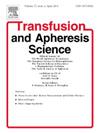遗传性出血性毛细血管扩张症输血患者的红细胞同种免疫:一项单中心回顾性研究。
IF 1.4
4区 医学
Q4 HEMATOLOGY
引用次数: 0
摘要
背景:遗传性出血性毛细血管扩张症(HHT遗传性出血性毛细血管扩张症(HHT)是一种遗传性血管疾病,可导致慢性出血和红细胞(RBC)输血。有关 HHT 患者输血需求和并发症的数据很少:加拿大多伦多圣迈克尔医院(SMH)进行了回顾性病历审查。2011年1月1日至2020年12月31日期间,所有临床诊断明确为HHT的成人住院患者均在SMH接受了输血相容性测试。数据摘录自电子病历。数据分析采用简单的描述性统计方法。结果:63名HHT患者接受了相容性测试:63名HHT患者接受了相容性测试,随后在SMH接受了输血。抽取数据时患者的中位年龄为70岁(四分位距[IQR]:18),35人(56%)为女性。在 23 名输血患者(36.5%)中发现了红细胞异体抗体,主要针对 Rh 抗原和 Kell 抗原:最常见的是抗-E(65%)、抗-K(39%)和抗-c(22%)。除去一名在研究期间接受了 611 个红细胞单位的异常值患者,SMH 为每名 HHT 患者平均输注了 22.1 个红细胞单位(标准偏差:40.9,IQR:17)。6名(9.5%)输血患者至少出现过一次输血反应:结论:在我们的输血型 HHT 患者队列中,红细胞异体免疫率为 36.5%,远高于普通人群和其他输血型 HHT 患者队列中的数据。最常见的异体抗体是 Rh 和 Kell,这支持了我们对所有输血的 HHT 患者进行这些抗原的预防性表型匹配的政策。本文章由计算机程序翻译,如有差异,请以英文原文为准。
Red blood cell alloimmunization in transfused patients with hereditary hemorrhagic telangiectasia: A single centre retrospective study
Background
Hereditary hemorrhagic telangiectasia (HHT) is a genetic blood vessel disorder which may lead to chronic bleeding and red blood cell (RBC) transfusions. Data on transfusion requirements and complications in HHT patients are sparse.
Study Design and Methods
Retrospective chart review was conducted at St. Michael’s Hospital (SMH) in Toronto, Canada. All adults with a definite clinical diagnosis of HHT AND inpatient hospital visits between January 1, 2011 and December 31, 2020 AND had undergone transfusion compatibility testing at SMH, were identified. Data were abstracted from electronic medical records. Simple descriptive statistics were used to analyze data. Institutional Research Ethics Board approval was obtained.
Results
63 HHT patients underwent compatibility testing and were subsequently transfused at SMH. Median patient age at data abstraction was 70 years (Interquartile Range [IQR]: 18) and 35 (56 %) were female. RBC alloantibodies were found in 23 transfused patients (36.5 %) and were predominantly directed against Rh and Kell antigens: Anti-E (65 %), Anti-K (39 %) and Anti-c (22 %) were most common. Excluding an outlier who received 611 RBC units during the study period, the mean number of RBC units transfused per HHT patient at SMH was 22.1 units (Standard Deviation: 40.9, IQR: 17). Six (9.5 %) transfused patients experienced at least one transfusion reaction.
Conclusion
RBC alloimmunization rate was 36.5 % in our cohort of transfused HHT patients; this is much higher than described in the general population and another transfused HHT cohort. The most commonly observed alloantibodies were Rh and Kell, supporting our policy of prophylactic phenotypic matching for these antigens for all transfused patients with HHT.
求助全文
通过发布文献求助,成功后即可免费获取论文全文。
去求助
来源期刊
CiteScore
3.60
自引率
5.30%
发文量
181
审稿时长
42 days
期刊介绍:
Transfusion and Apheresis Science brings comprehensive and up-to-date information to physicians and health care professionals involved in the rapidly changing fields of transfusion medicine, hemostasis and apheresis. The journal presents original articles relating to scientific and clinical studies in the areas of immunohematology, transfusion practice, bleeding and thrombotic disorders and both therapeutic and donor apheresis including hematopoietic stem cells. Topics covered include the collection and processing of blood, compatibility testing and guidelines for the use of blood products, as well as screening for and transmission of blood-borne diseases. All areas of apheresis - therapeutic and collection - are also addressed. We would like to specifically encourage allied health professionals in this area to submit manuscripts that relate to improved patient and donor care, technical aspects and educational issues.
Transfusion and Apheresis Science features a "Theme" section which includes, in each issue, a group of papers designed to review a specific topic of current importance in transfusion and hemostasis for the discussion of topical issues specific to apheresis and focuses on the operators'' viewpoint. Another section is "What''s Happening" which provides informal reporting of activities in the field. In addition, brief case reports and Letters to the Editor, as well as reviews of meetings and events of general interest, and a listing of recent patents make the journal a complete source of information for practitioners of transfusion, hemostasis and apheresis science. Immediate dissemination of important information is ensured by the commitment of Transfusion and Apheresis Science to rapid publication of both symposia and submitted papers.

 求助内容:
求助内容: 应助结果提醒方式:
应助结果提醒方式:


